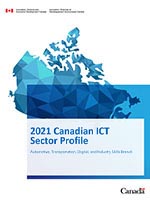This publication is available online at http://www.ic.gc.ca/eic/site/ict-tic.nsf/eng/h_it07229.html.
To obtain a copy of this publication, or to receive it in an alternate format (Braille, large print, etc.), please contact:
Web Services Centre
Innovation, Science and Economic Development Canada
C.D. Howe Building
235 Queen Street
Ottawa, Ontario K1A 0H5
Canada
Telephone (toll-free in Canada): 1-800-328-6189
Telephone (international): 613-954-5031
TTY (for hearing impaired): 1-866-694-8389
Business hours: 8:30 a.m. to 5:00 p.m. (Eastern Time)
Email: ISED@canada.ca
Permission to Reproduce
Except as otherwise specifically noted, the information in this publication may be reproduced, in part or in whole and by any means, without charge or further permission from the Department of Industry, provided that due diligence is exercised in ensuring the accuracy of the information reproduced; that the Department of Industry is identified as the source institution; and that the reproduction is not represented as an official version of the information reproduced, or as having been made in affiliation with, or with the endorsement of, the Department of Industry.
For permission to reproduce the information in this publication for commercial purposes, please fill out the Application for Crown Copyright Clearance at www.ic.gc.ca/copyright-request or contact the Web Services Centre mentioned above.
© Her Majesty the Queen in Right of Canada, as represented by the Minister of Industry, 2022
Cat. No. Iu62-2E-PDF
ISSN 1913-0171
Aussi offert en français sous le titre Profil du secteur canadien des TIC 2021
PDF version
2021 ICT Sector Snapshot
Canada’s ICT sector posted strong growth in 2021 despite the impacts of the pandemic, especially in ICT services, and outperformed the overall Canadian economy in terms of output, employment, and innovation growth.
| Revenue (est) | GDP | Good Exports | Services Exports | |
|---|---|---|---|---|
| Size | $242B | $104.5B | $9.7B | $21.9B |
| 2021 Growth | +4.7% | +4.7% | +4.0% | +5.9% |
| Share of Economy | N/A | 5.3% | 1.5% | 22.5% |
|
45,023 companies
|
||||
| Innovation | 2021 Growth | Share of Economy |
|---|---|---|
|
59% of workers have a University Degree
|
||
| $10.3B in Business R&D spending | +9.1% | 44.1% |
| Workforce | 2021 Growth | Share of Economy |
|---|---|---|
|
Average Salary 52.5% higher than Canadian Average
|
||
| 717,597 Workers | +5.7% | 3.8% |
| $89,630 in Annual Average Salary | +7.5% | N/A |
Sub-Sector Trends
| Revenues ($millions) | Employment | GDP ($millions) | R&D ($millions) | |||||
|---|---|---|---|---|---|---|---|---|
| 2021 | CAGR 5 Year | 2021 | CAGR 5 Year | 2021 | CAGR 5 Year | 2021 | CAGR 5 Year | |
| ICT Manufacturing | 10,463 ▲ | 3.8% | 32,282 ▼ | -1.7% | 3,456 ▲ | 0.0% | 821 ▲ | 4.6% |
| Software & Computer Systems | 106,334 ▲ | 9.9% | 504,050 ▲ | 5.9% | 54,230 ▲ | 7.7% | 6,535 ▲ | 8.6% |
| Communications Services | 67,048 ▲ | 2.0% | 122,757 ▲ | -2.2% | 39,619 ▲ | 2.7% | 1,634 ▬ | 9.1% |
| ICT Wholesaling | 58,156 ▬ | 5.7% | 57,508 ▼ | 1.8% | 7,208 ▼ | 2.7% | 1,344 ▲ | 9.8% |
Economic and Employment Impacts of ICT (2021)
| Impact on Canadian GDP ($millions) | Impact on Canadian Employment ($persons) | |||||||
|---|---|---|---|---|---|---|---|---|
| Direct | Indirect | Induced | Total | Direct | Indirect | Induced | Total | |
| ICT Manufacturing | 3,456 | 1,617 | 1,694 | 6,764 | 33,882 | 15,844 | 16,886 | 65,612 |
| Software & Computer Systems | 54,230 | 26,525 | 28,335 | 109,090 | 395,950 | 250,030 | 233,875 | 879,855 |
| Communications Services | 39,619 | 16,842 | 9,663 | 66,124 | 122,457 | 127,577 | 76,379 | 326,413 |
| ICT Wholesaling | 7,208 | 2,253 | 3,174 | 12,634 | 55,708 | 22,536 | 30,678 | 108,922 |
| ICT Total | 104,513 | 47,236 | 42,866 | 194,612 | 606,997 | 415,987 | 357,818 | 1,380,802 |
The ICT sector creates important economic and employment impacts within the economy. Indeed, each direct job in the ICT sector supports an additional 1.3 jobs within the Canadian economy and each $1 million of direct GDP generated within the ICT sector leads to an additional $862,000 in GDP generated for Canada. Within the ICT sector, software and computer services generates the highest impact multiplier in terms of GDP, whereas communications services has the highest impact multiplier in terms of employment (1.7 multiplier).
Industry structure
There are over 45,000 companies in the Canadian Information and Communications Technologies (ICT) sector and the large majority (over 40,000) fall within the software and computer services industries.
Figure 1: Companies by ICT sub-sector, 2021

The ICT sector consists mainly of small companies, with approximately 38,270 of them employing fewer than 10 people. There are 123 large companies employing over 500 individuals, including subsidiaries of foreign multinational corporations. Manufacturing stands out as the sub-sector with a larger share of large firms. In 2021, 8.5% of ICT manufacturing companies had more than 100 employees, while across the whole ICT sector this share was only 1.7%.
Figure 2: Companies by employee size for total ICT sector, 2021

ICT sector industries
ICT manufacturing
- Computer and peripheral equipment
- Communications equipment
- Electronic components
- Audio and video equipment
- Magnetic and optical media
ICT wholesaling
- Computer, computer peripheral and prepackaged software merchant wholesalers
- Electronic components, navigational and communications equipment and supplies merchant wholesalers
Software and computer services
- Software publishers
- Computer systems design
- Data processing
- Electronic and precision equipment repair and maintenance
Communications services
- Wireless telecommunications carriers
- Wired telecommunications carriers
- Cable and other program distribution
GDP contribution
The ICT sector contributes substantially to Canada’s GDP . In 2021, the sector’s GDP was $104.5 billion (in 2012 constant dollars), accounting for 5.3% of national GDP, continuing a trend of taking a higher share of national GDP. The ICT sector is also responsible for 15.3% of national GDP growth between 2016 and 2021.
Since 2016, the ICT sector has posted a stronger annual growth than the total economy. On average, the compound annual growth rate in this sector has been 5.0% over a five year period, compared to 1.6% for the overall economy.
The sector’s strong growth continued in 2021 with GDP up 4.7%, however it was outpaced by the Canadian economy that grew by 5.0% as it recovered from declines due to the impacts of the COVID-19 pandemic. While most ICT sub-sectors experienced positive growth in 2021, ICT wholesaling saw a 1.4% contraction in output. ICT manufacturing posted the strongest growth, up 14.4%. Meanwhile, software and computer services expanded by 8.1% and communications services by 0.6%.
Annual growth within ICT industries varied widely. Computer and peripheral equipment manufacturing (+25.2%), semiconductor and electronic component manufacturing (+17.2%) and communications equipment manufacturing (+15.6%) companies posted the fastest annual GDP growth in 2021 recovering from steep declines in 2020. Many service industries, such as data processing (+17.7%) and computer systems design (+7.6%), continued to grow despite the pandemic.
Figure 3: GDP by ICT sub-sector, 2021
(Total: $104.5 Billion)
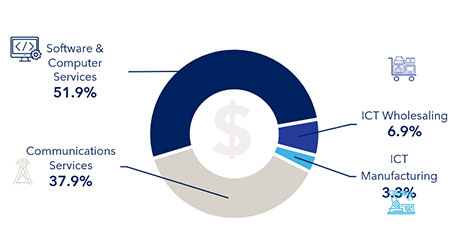
Figure 4: ICT sector GDP , 2016–2021
(2012 constant dollars)
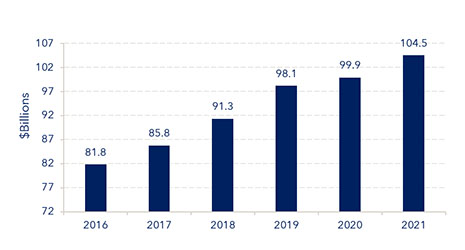
Revenues
ICT sector revenues reached an estimated $242 billion in 2021. All ICT sub-sectors recorded positive growth in 2021. ICT manufacturing led in growth with its revenues up 15.3% after falling sharply the prior year. Despite the pandemic, software and computer services revenues grew 6.4%, while ICT wholesaling (+4.7%) and communications services (+0.6%) sub-sectors experienced slower growth.
From 2016 to 2021, ICT sector revenues grew from $180 billion to $242 billion, a 34.4% increase. During the same five-year period, communications services saw their revenues grow by just 10.1%. On the other hand, other ICT sub-sectors posted greater gains: the software and computer services, ICT wholesaling, and the ICT manufacturing sub-sectors increased by 60.1%, 31.9%, and 20.6% respectively. Over the same period, ICT manufacturing and communications services saw their revenue shares drop from 4.8% to 4.3% and 33.8% to 27.7%, respectively, of total ICT sector revenues.
Figure 5: Revenues by ICT sub-sector, 2021
(Total: $242 billion)

Figure 6: ICT sub-sector revenues, 2016–2021

Exports
The Canadian ICT manufacturing sub-sector relies heavily on the export market, which was significantly reduced as a result of the impacts of COVID-19, lowering economic activity throughout 2020 and 2021. ICT goods account for almost 1.5% of total Canadian exports, down from 2% pre-pandemic. Total Canadian exports of ICT goods remain 14% lower than 2019 at $9.7 billion in 2021, however they have increased by 4.0% from 2020. Exports of electronic components and computer equipment recovered the most (6.3% year-on-year), while computer and peripheral equipment and communications equipment exports grew 3.0% and 2.5%, respectively, from 2020 figures.
Figure 7: Exports of ICT goods by product group, 2021
(Total: $9.7 Billion)
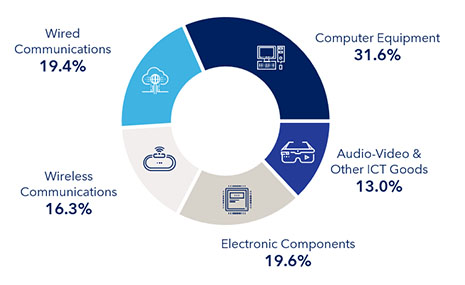
Between 2016 and 2021, exports of ICT goods fell 14.5% compared to a 20.5% increase in imports over the same time period. Since 2016, exports of audio and video equipment have experienced the largest decline (-35.4%), while only magnetic and optical media showed an increase in exports.
Exports of ICT goods to the United States held steady at about $6.4 billion in 2021 accounting for 66.1% of all ICT goods exported from Canada. In 2021, exports to the Asia-Pacific region increased by 6.5%, while they increased significantly to the European Union, up 20.3%. The Asia-Pacific region accounted for 13.8% of all Canadian exports of ICT goods, while the European Union accounted for just 10.4%, compared to 9.0% in 2020. Exports to all other countries also grew in 2021 (+14.9%).
While ICT service industries are very domestically oriented they also provide an important contribution to increasing export diversification. In 2021, exports of ICT communications services grew by an estimated 4.6%, to $1.6 billion, while software and computer service exports grew by an estimated 6.0% to $20.3 billion. Exports accounted for about 19% of software and computer services revenues, while the figure was just 2% for communications services revenues. Overall exports of ICT services were projected to reach $21.9 billion in 2021, up 5.9% from 2020.
It is estimated that overall Canadian exports of ICT goods and services grew between 2020 and 2021 by 5.3%, but grew at a 6.5% CAGR from 2016 to 2021 to reach $31.6 billion.
Figure 8: Exports of ICT goods by region, 2021
(Share of total)
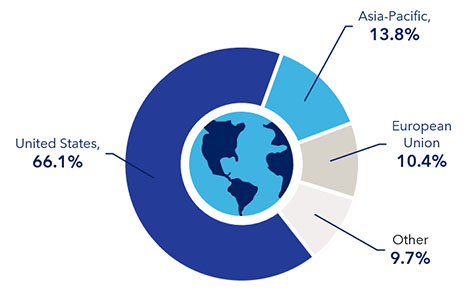
Figure 9: Exports of ICT goods and services,
2016–2021 ($ billions)
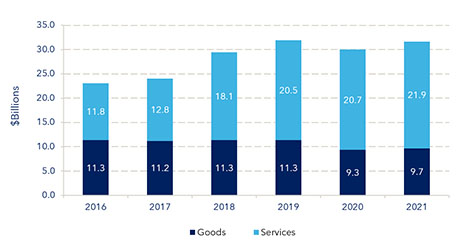
Research & development
ICT industries are the largest performers of R&D in the Canadian private sector. In 2021, the sector held a 44.1% share of all private sector R&D expenditures in Canada. ICT sector R&D expenditures totaled $10.3 billion in 2021, up 9.1% from the previous year. Communications and data hosting services saw the largest reduction in R&D spending (-1.9%), while the largest increases were in software and computer services (+12.5%) and ICT Manufacturing (+12.6%).
Figure 10: R&D expenditures by ICT industry, 2021
(Total: $9.8 billion)
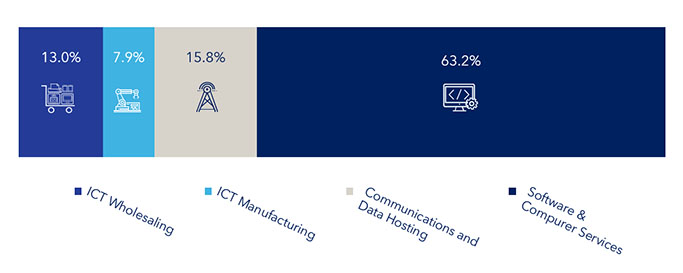
Employment
Employment growth in the ICT sector has been outpacing the overall economy for many years, between 2016 and 2021 average annual growth for ICT was 3.5%, but just 0.9% for the overall economy. In 2021 the ICT sector saw growth of 5.7% compared to a 4.4% in the overall economy. In 2021, more than 717,590 individuals were working in the ICT sector, accounting for more than 3.8% of the Canada’s total employment.
The sector’s performance in 2021 was led by a 16.4% jump in the data processing, hosting and related services’ workforce. Employment levels in ICT manufacturing and communications services sub-sectors decreased by 1.8% and 0.7% respectively while employment in software publishing and computer systems design services grew by 13.3% and 9.1%, respectively.
Figure 11: ICT sector employment, 2016–2021

Between 2016 and 2021, total employment growth in software and computer services has outpaced overall growth in the ICT sector (5.9% vs. 3.5%). The total ICT sector workforce grew 18.8% from 604,240 in 2016 to just over 717,590 in 2021. Software and computer services’ share of employment has increased from 63% to 70% over that same time period, reflecting the rising proportion of service firms in the ICT sector compared to other sub-sectors such as manufacturing.
Figure 12: Employment by ICT sub-sector, 2021
(Total: 717,597 workers)

Education
The ICT sector is characterized by a knowledge-intensive workforce, with over half of its workers holding a university degree, compared to 34.0% within all Canadian industries. The software and computer services sub-sector employs the largest proportion of university educated workers within the ICT sector (65.2%).
Figure 13: Percentage of workers with a university degree by industry category, 2020
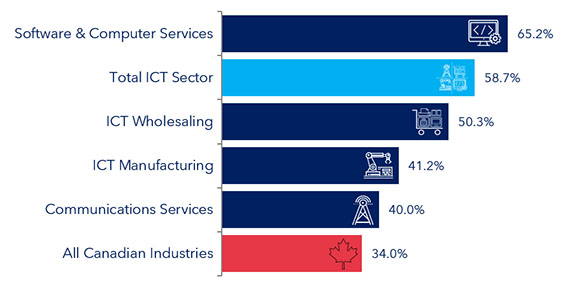
Employee earnings
Employees in the ICT sector earn on average over $89,630 per year. In 2021, they earned 52.5% more than the economy-wide average, up from the 46.2% premium in 2020.
The highest earners in the ICT sector were those in software and computer services and wholesaling sub-sectors. Despite having the lowest average earnings in the ICT sector, employees in the communications services sub-sectors still earned 23.8% more than the national average in 2021.
From 2016 to 2021, the average salary in the ICT sector grew by 3.4% per year, the same average rate as salaries in the overall economy.
Figure 14: Average annual earnings by industry category, 2021
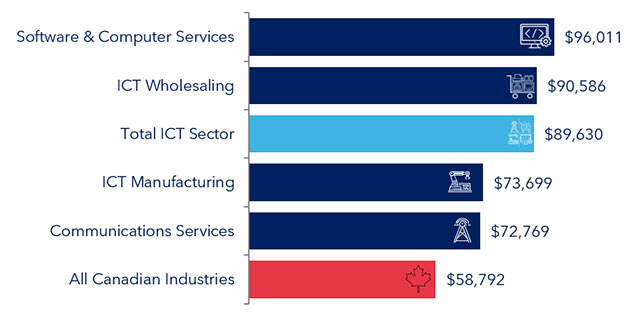
Sector Outlook and COVID–19 Impact
In recent years, the ICT sector has demonstrated strong economic performance with all ICT services and some ICT manufacturing industries (e.g., electronic components) outperforming the rest of the Canadian economy. However, the trends of the 2010s were interrupted by the ongoing COVID-19 pandemic and the long-term impacts are yet to be determined.
While the ICT sector has generally weathered the pandemic better than most sectors, it is still expected to create challenges for many ICT firms. In 2020, small- and medium-sized enterprises (SMEs) in the ICT sector were about three times less likely to temporarily close operations due to the COVID-19 pandemic than SMEs in general, 13.7% vs 33.4%. However, the pandemic caused more than 5,800 ICT SMEs to temporarily close, and those ICT SMEs that did close temporarily were closed for a longer duration than other SMEs, for 18 weeks on average compared to 12 weeks for all SMEs across the economy.
Figure 15: Share of ICT SMEs using Government Programs, 2020
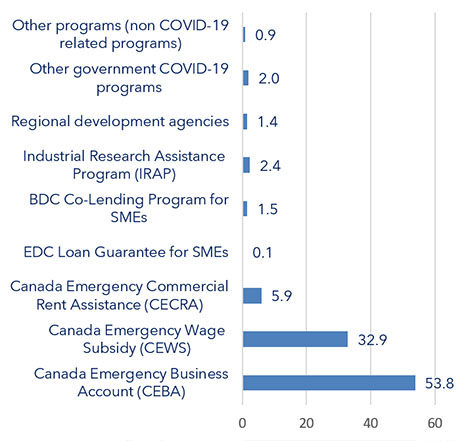
Over two-thirds (67.9%) of SMEs in the ICT sector requested external financing* in 2020; 65.5% applied for government financing. This represents a significant increase from 2017, where 32.2% of ICT sector SMEs requested external financing and just 6% sought government financing. This change is driven by government support programs widely used by SMEs during the COVID-19 pandemic, although overall ICT SMEs were still less likely to use COVID assistance programs than SMEs in other sectors of the economy. In 2020, ICT SMEs received $1.6 Billion in new government grants, subsidies, government guaranteed loans or non-repayable contributions.
ICT sector SMEs reported in 2020 that obtaining financing was much less of an obstacle to growth than fluctuating demand and increasing competition. Obtaining financing was a major to moderate obstacle for just 22.8% of ICT SMEs while fluctuating demand was a major to moderate obstacle for 47.6% and increasing competition for 46.9%. While not every firm will face reduced sales, all of them will have to continue to adapt to shifting demand, strained supply chains and altered working arrangements. The Canadian ICT sector is facing headwinds in the form of a global semiconductor shortage, increased viability of remote work that could spark higher competition for talent, and implementation of “buy local” policies in major export markets.
Fortunately, the ICT sector is well positioned to benefit from the economy-wide recovery as demand is expected to reflect accelerating adoption of many technology solutions and private and public investments in digital infrastructure.
(External financing includes any request for a non-residential mortgage, business line of credit, term loan, business credit card, lease financing, trade credit financing, equity financing or government financing.)
Data Sources
- Companies:
- ISED calculations using data from Statistics Canada’s Business Registry.
- Revenues:
- Manufacturing: Statistics Canada, Table 16-10-0117-01;
- Software and Computer Services: Statistics Canada, Table 22-10-0087-01 and custom tabulations;
- Communications Services: Statistics Canada, Table 22-10-0003-01;
- Wholesale: Statistics Canada Table, 20-10-0077-01; and
- ISED estimates for the most recent year presented (for all ICT industries).
- GDP :
- Statistics Canada custom tables.
- Employment:
- Statistics Canada, Survey of Employment, Payroll, and Hours (SEPH) for the number of employees and Labour Force Survey (LFS) for the number of self-employed (custom tables).
- Research & Development:
- Statistics Canada, Table 27-10-0333-01.
- Education:
- Statistics Canada, Labour Force Survey custom tables.
- Employee Earnings:
- ISED calculations using Statistics Canada, Tables 14-10-0202-01 and 14-10-0204-01.
- Exports:
- Goods: ISED calculations using Trade Data Online data;
- Services: Statistics Canada, Table 36-10-0006-01.
- Economic and Employment Impacts:
- o ISED calculations using GDP (custom tables), Employment (Survey of Employment, Payroll, and Hours (SEPH)) and Statistics Canada, Input-output multipliers, Table: 36-10-0594-01
- Outlook and COVID:
- o Worldwide Black Book 3rd Platform Edition, 2017–2023, IDC, 2020.
- Statistics Canada, Survey on Financing and Growth of Small and Medium Enterprises, 2020 and 2017.

